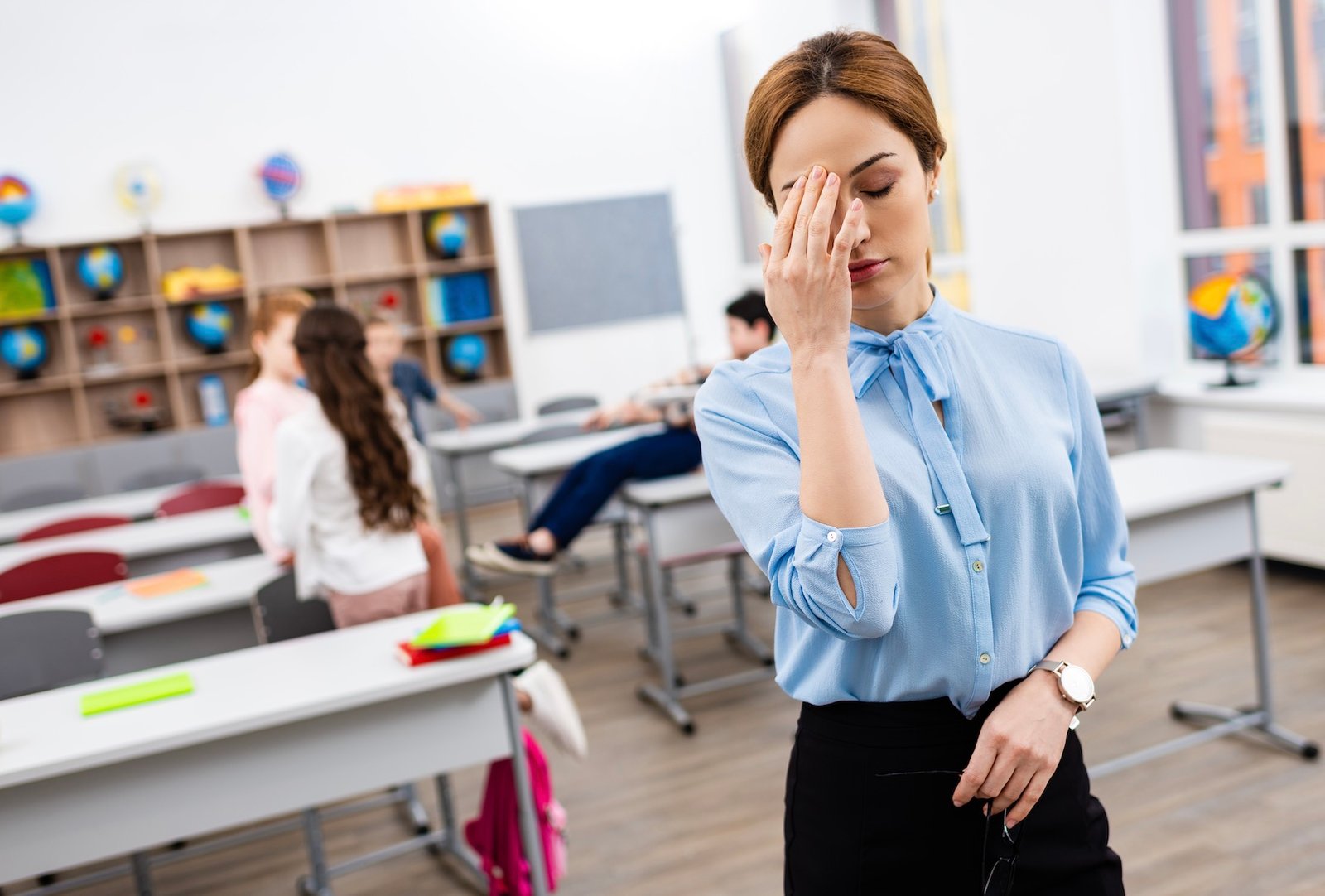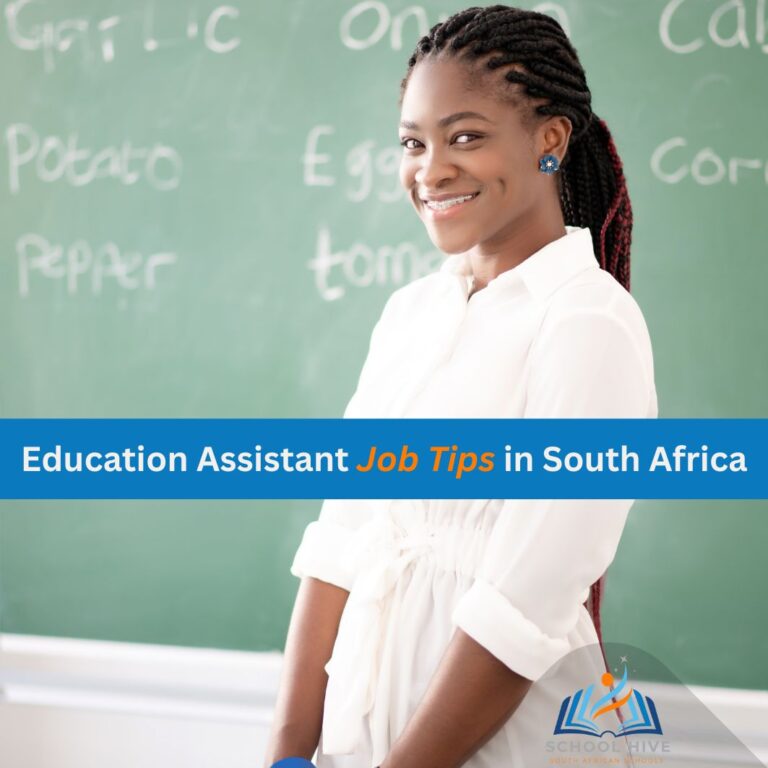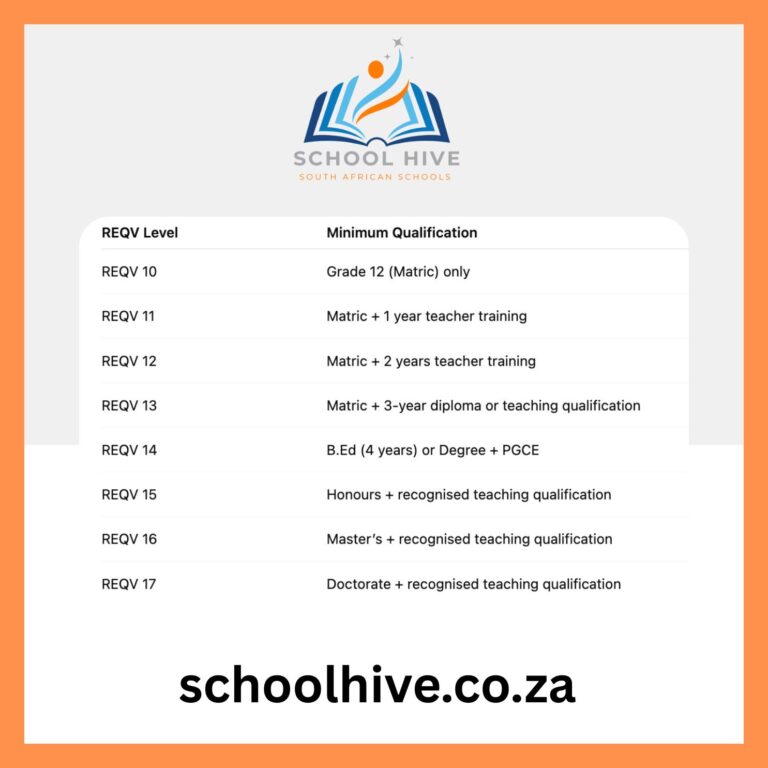There are nine main types of leave for teachers in South African public schools, which are: annual leave, sick leave, temporary incapacity leave, permanent disability leave, leave for occupational injuries and diseases, maternity leave, adoption leave, family responsibility leave, and study leave.
On this page, we will explore each leave type for teachers in South African public schools under the Department of Basic Education. This will give you an indication of the leave benefits that public school teachers receive, especially when compared to private school teachers who often do not enjoy the same protections or structured policies.
To give you a quick summary of all leave types for teachers in public schools, here is a full list:
- Annual Leave – 22 to 28 working days, depending on years of service
- Sick Leave – 36 working days over a 3-year cycle
- Temporary Incapacity Leave – Applied for after sick leave is exhausted, subject to approval
- Permanent Disability Leave – Up to 30 days paid while processes are finalised
- Leave for Occupational Injuries and Diseases – Full period of absence covered
- Maternity Leave – 4 consecutive calendar months
- Adoption Leave – Up to 45 working days (child under 2 years)
- Family Responsibility Leave – Up to 5 days per year
- Study Leave – 2 days per exam, up to 10 or 15 days per course in special cases
In the next section, we will explore each of the leave types for teachers in public schools.
---Advert---
9 Types of Leave for Teachers in South African Public Schools
Let us explore in details each leave type for South African teachers in public schools, based on the Department of Education Leave Policy which governs leaves for educators in public schools:
1. Annual Leave for Teachers in South African Public Schools
Annual leave for teachers in public schools is regulated by the Department of Basic Education and applies per 12-month cycle starting on 01 January each year. The number of leave days depends on your years of service and role type.
Here is the allocation:
- 28 working days if employed before 1 July 1966
- 26 working days if you have 10 years or more of continuous service
- 22 working days if you have less than 10 years of continuous service
- 36 calendar days for shift workers (security staff) with 10 years or more
- 30 calendar days for shift workers (security staff) with less than 10 years
Leave is taken from your previous cycle first. When that is finished, it starts deducting from the current cycle. If both are used up, then capped leave is affected. If there is no capped leave, the extra days become unpaid.
In contrast, private school teachers do not have a fixed national leave structure like in the public schools. Their annual leave is entirely based on the school’s internal HR policy. In many cases, private teachers are told that school holidays are their leave, but in practice, this does not always include formal paid leave. There are also schools where teachers are only paid for the active terms and nothing during breaks, unless stated otherwise in the contract.
If you started working after 01 January in a public school, your leave is calculated pro-rata. Temporary employees receive leave in proportion to their contract, calculated as 1/12th of the full allocation per month worked.
Public school teachers are required to take at least 10 consecutive working days during the cycle. The rest must be used within 6 months after the cycle ends. If not, the days fall away unless leave was formally refused and documented.
In public schools, if leave is refused due to departmental needs and you have proof, you can apply for a payout for those unused days after 18 months. Most private schools do not offer payouts for unused leave unless it is part of a formal agreement.
Leave taken during religious or cultural holidays not listed in the Public Holidays Act is treated as vacation leave in public schools.
If you take unpaid leave in the public system, your annual leave balance is reduced. For every 15 consecutive days of unpaid leave, your accrual drops slightly. Private teachers often find that any time taken outside of the school’s break calendar is unpaid, regardless of the reason or how small the number of days is.
Payment of Annual Leave
In public schools, if you resign or your service ends, you are paid out for unused leave, up to a maximum of 22 working days. This excludes capped leave. At retirement, due to illness, or death, you are paid out for both unused and capped leave. A nominated beneficiary can be appointed to receive this if you pass away.
In private schools, payouts for unused leave are not always guaranteed and depend entirely on what is written in the contract. If it is not in writing, there is usually no payout. Many teachers discover this only when they leave.
Taking More Leave Than You Have
Public teachers may apply for extra leave in special cases. If approved, the extra days come off your capped leave. If there is no capped leave, it becomes unpaid. Any leave longer than six weeks must go through the Chief Director for approval.
Annual Leave with Pay and Without Pay
In public schools, if you take leave and later resign, it still counts as paid leave. But if you resign and then apply for leave during your notice period, it becomes unpaid. You are not allowed to use leave to push your final working date unless approved.
Transfers Between Departments
If you move from one public department to another without a break, your leave credit moves with you. If there is a break in service, your leave starts from zero. Private schools do not have this kind of structured portability. A new job means a new contract, and your previous leave credit is lost.
Rehabilitation and Support Cases
If a public school teacher struggles with alcohol, drug problems, or social issues, they can use annual leave to attend rehabilitation. A report and medical certificate must be submitted after treatment. If there is no leave available, the department may still grant the days and recover them from future accruals or final payout.
2. Sick Leave for Teachers in South Africa
Teachers in South African public schools are entitled to 36 working days of sick leave in a 3-year cycle. This leave is for illness only and must be used according to departmental rules.
- Any unused sick leave at the end of the cycle falls away. It does not carry over to the next cycle.
- The sick leave cycle is fixed and does not restart based on employment dates.
If a teacher is absent more than twice within an 8-week period, they must provide a medical certificate, no matter how short each absence was. If no certificate is submitted, the department will either:
- Deduct the leave from annual leave (only if you agree in writing), or
- Record the time as unpaid leave
The 8-week period starts on the first day you are absent due to illness. A new 8-week cycle starts only after this full period has passed.
If your 36-day allocation runs out, and you are still unwell, you must apply for temporary incapacity leave. This is not automatic. It must be approved and supported with medical evidence.
Every day of sick leave must be backed by a valid medical certificate. Without it, the day will be treated as vacation leave or leave without pay, depending on your remaining leave balance.
Sick leave also covers periods of quarantine or isolation, provided proper documentation is submitted.
If you become ill suddenly and cannot report to work, you are required to inform your supervisor immediately.
Any sick leave application for three or more days must be supported by a certificate from a registered medical practitioner, recognised by the Health Professions Council of South Africa. The certificate must clearly state the diagnosis and how many days you are booked off.
Sick leave is also granted for long-term conditions such as diabetes, high blood pressure, or other recognised chronic illnesses.
For basic medical tests like eye checks or blood tests, you must apply for annual leave. Only when a doctor issues a sick note will it be considered sick leave.
If your sick leave shows a repeated pattern (for example, regularly absent on Mondays or before holidays), the department may require a certificate even for single-day absences.
For every 15 consecutive days of unpaid leave, your sick leave allocation is reduced by 1/36th of your total entitlement.
Unlike in the public sector, most private school teachers do not receive a standard 36-day cycle. In many private schools, the number of sick leave days is set in the employment contract and may be as little as 10 days per year, regardless of illness history.
Conversion of Annual Leave to Sick Leave
If you fall ill during your annual leave, those days can be converted into sick leave, but only if you submit a valid certificate from a registered doctor, traditional healer, homeopath, or medical specialist. No certificate, no conversion.
Medical Examination
If you are regularly off sick or your absence follows a trend, the Director: Staffing Services may refer you for a medical examination by one or more doctors selected by the department. The department will pay the full cost.
You can also ask for a doctor of your own choice to be present during the examination. The medical report will be used to assess whether further action is needed.
In most private schools, this process does not exist formally. If a private teacher is often ill, there are usually informal discussions or disciplinary steps, not a formal medical referral.
Sick Leave for Contract Teachers
Teachers on fixed-term contracts qualify for sick leave based on the duration of their contract. For example:
- A 12-month contract allows for 12 days of sick leave, unless stated otherwise in the contract.
Sick Leave for Temporary Teachers
Teachers employed in a temporary capacity qualify for sick leave at a rate of one day for every month worked.
- A 6-month temporary post = 6 days sick leave
- A 3-month post = 3 days sick leave
In both public and private sectors, temporary appointments generally offer limited sick leave, but public sector rules are more consistent and formalised.
3. Temporary Incapacity Leave for Public School Teachers
Teachers in the public education system are entitled to temporary incapacity leave, but only after they have fully used their 36 working days of sick leave. For those who do not know, temporary incapacity leave is a type of leave granted when you are still too ill to return to work, but your standard sick leave has already been exhausted.
A typical example of this would be a teacher who had surgery or is undergoing long-term treatment for a serious illness, and needs more recovery time even after their 36 sick leave days are finished.
Once your normal sick leave runs out, any further applications for sick leave are automatically treated as temporary incapacity leave. There is no set limit on how many days you can apply for during the rest of the cycle — but every single application must come with a proper medical certificate, no matter how many days you are requesting.
The Director-General can approve a maximum of 30 consecutive days at a time, and during that time, the department will investigate the nature and seriousness of your condition. This is not optional. They may request more medical reports or follow-up check-ups with their own appointed doctors. Depending on the findings, they may also attach specific conditions to your continued leave.
Private school teachers generally do not have access to formal temporary incapacity leave. Once their sick leave days are used up, most are simply expected to return to work, or take unpaid leave. That is why public sector policies offer more protection in cases of long-term illness.
4. Permanent Disability Leave for Public School Teachers
As a teacher in a public school, you are entitled to permanent disability leave, which is determined on the basis of your condition being officially declared permanent by a competent medical practitioner. It applies when you are no longer medically fit to continue working in your current role, even after extended treatment or recovery.
If you are granted permanent disability leave, it simply means you are no longer required to return to your current post because your health does not allow it. The process starts with a maximum of 30 working days of paid sick leave, which is used to finalise what steps will follow.
Examples of when this may apply include:
- You have become permanently injured or impaired
- You are diagnosed with a medical condition that makes it impossible to continue teaching
- Your recovery is no longer expected to reach the level needed for full job duties
Within those 30 working days, the department must determine the best possible way forward. They will assess:
- Whether they can offer you alternative employment
- Whether your duties or working conditions can be adjusted to suit your health
- Or if the best option is to terminate your service due to continuous ill health, according to the Government Employees Pension Law of 1996 or PSCBC Resolution No. 12 of 1999
If your condition is permanent, but you are still able to work in another capacity, you may be redeployed to a different role. This is known as horizontal redeployment, and you will keep all your benefits.
If the new post has a lower salary grade, the department must explain this clearly in advance. Your agreement is required. No one can be forced into a downgraded position without being fully informed.
The aim is to make sure your skills are still used effectively, without putting pressure on your health or the school’s operations.
5. Leave for Occupational Injuries and Diseases
If you are a public school teacher and you get injured while on duty or you contract a disease as a direct result of your work, you are entitled to occupational injury and disease leave.
This type of leave covers the entire period that you are unable to perform your duties because of the injury or illness. There is no limit to the number of days — the leave continues for as long as you are medically unfit to return.
This applies strictly to incidents that happen while performing official duties or that are proven to be work-related conditions.
Unlike normal sick leave, this leave is handled separately and does not affect your 36-day sick leave cycle.
6. Maternity Leave for Public School Teachers
Like in many industries in South Africa, public school teachers are entitled to four consecutive calendar months of maternity leave. This leave must start:
- At least 4 weeks before the expected date of birth, or
- On a date certified by the attending practitioner if required for the health of the teacher or the unborn child.
After giving birth, you are not allowed to return to work for at least six weeks, unless a medical practitioner certifies that you are fit to do so.
Maternity leave can be extended by applying for:
- Sick leave (if there are medical complications)
- Unpaid leave (up to 184 calendar days)
- Or annual leave
If a miscarriage, stillbirth, or termination on medical grounds happens during the third trimester, you are eligible for six consecutive weeks of maternity leave. If medical complications follow, you can then apply for extended sick leave under the same terms.
If the miscarriage, stillbirth, or termination occurs after maternity leave has already started, the time leading up to the event will be treated as special leave with full pay, and the six weeks of maternity leave will still apply from the date of the incident.
Teachers employed in temporary or contract positions do not qualify for paid maternity leave. This applies even if the contract is long-term unless otherwise stated in writing.
If a child passes away within two months of birth, the teacher qualifies for six weeks of maternity leave. If the child passes away during the final month of the four-month leave, the teacher is entitled to complete the full remaining leave period.
In most private schools, paid maternity leave is not guaranteed. It usually depends on the internal HR policy or your individual contract. Many private teachers are required to use annual leave or take unpaid leave unless the school offers formal maternity benefits.
7. Adoption Leave for Public School Teachers
If you are a teacher in a public school and you legally adopt a child younger than two years old, you qualify for adoption leave of up to 45 working days.
Once the 45 days are used up, you can apply to extend the time by:
- Taking unpaid leave (up to 184 calendar days), or
- Using your available annual leave
If both partners are employed in the public service, they may share the 45 days, but the combined total may not exceed it.
In private schools, adoption leave is not always offered formally. Many private school contracts do not include adoption leave at all, and leave must be taken from annual leave or recorded as unpaid unless otherwise stated in the policy.
8. Family Responsibility Leave for Public School Teachers
Public school teachers are entitled to five days of family responsibility leave per annual leave cycle.
Out of the five days:
- A maximum of three days can be used if:
- Your spouse or life partner gives birth, or
- An immediate family member is ill (a medical certificate is required)
- The full five days can be used if an immediate family member passes away
If you used family responsibility leave while the family member was still ill, and they later pass away, you will be granted the remaining balance of the five days. Any extra time needed will be deducted from annual leave or counted as unpaid leave.
If you have already used your five days and need more time, you may:
- Apply to use any remaining annual leave, or
- Request up to 184 calendar days of unpaid leave
9. Study Leave for Teachers
Study leave for South African teachers at public schools is classified under three main categories, which are:
- Examination Leave
- Study Leave for Preparation or Research
- Class Attendance and Practical Work
Let us look at these closely below:
1. Examination Leave
Teachers qualify for 2 days of special leave per examination if the course is in line with their current job and relevant to the Department’s interests. One day is for writing the exam, and one day is for preparation. If the exam falls on a Monday, the Friday before counts as the prep day. An official exam timetable must be submitted.
2. Study Leave for Preparation or Research
You may be granted 2 days of special leave per subject per exam. For research-intensive studies like a thesis or doctorate, the Department allows up to 15 working days per course. In addition, teachers can apply for a maximum of 10 special leave days per year for:
- Study tours abroad
- Writing postgraduate essays or theses
- Practical work required by the qualification
- Preparatory courses or development programmes
If you need more time than allowed, you can apply to use your annual leave or request unpaid leave.
3. Class Attendance and Practical Work
Teachers studying part-time and attending classes or workshops during work hours qualify for 1 day of special leave for every 16 hours away. If you are studying toward a Senior Certificate, you can be released from duty for up to 8 hours per working week. Teachers in departmental training may be released for practicals and classes as required by their course.
……..
On this page, we have explained all the leave types available to teachers at public schools and also pointed out that private schools do not follow the same structure. While public school teachers are guided by national policies and formal procedures, most private school teachers rely on what is written in their individual contracts or internal school policies.
Now you know what you are entitled to, what is limited, and what needs proper documentation. It is always advisable to keep a personal record of your leave, follow the right channels when applying, and never assume anything not confirmed in writing.
---Advert---






